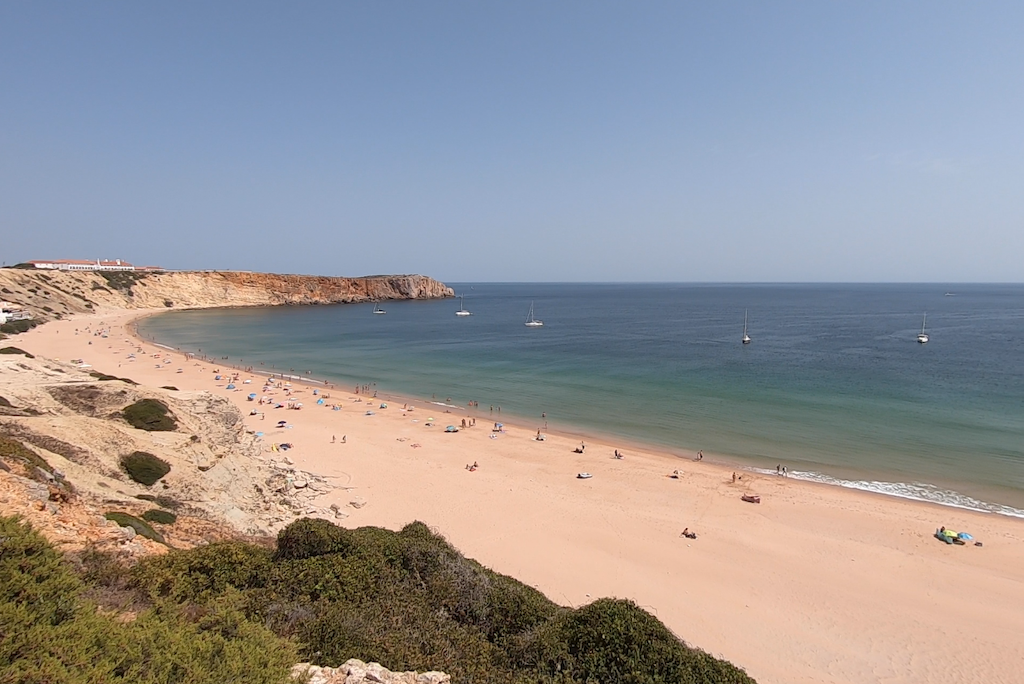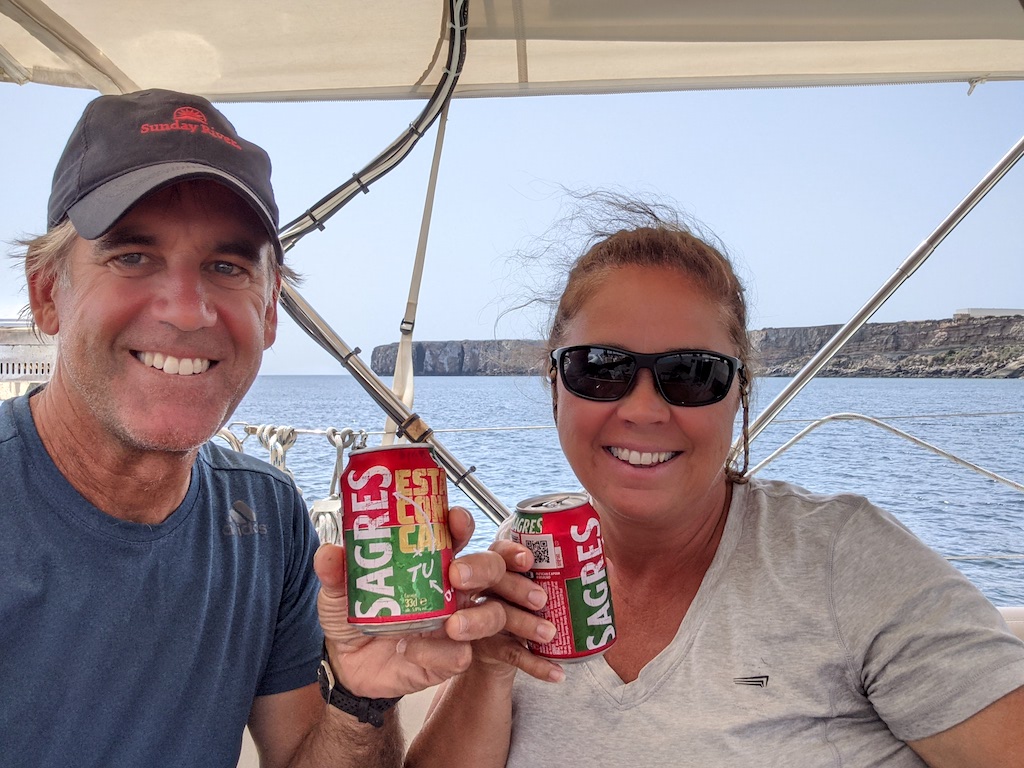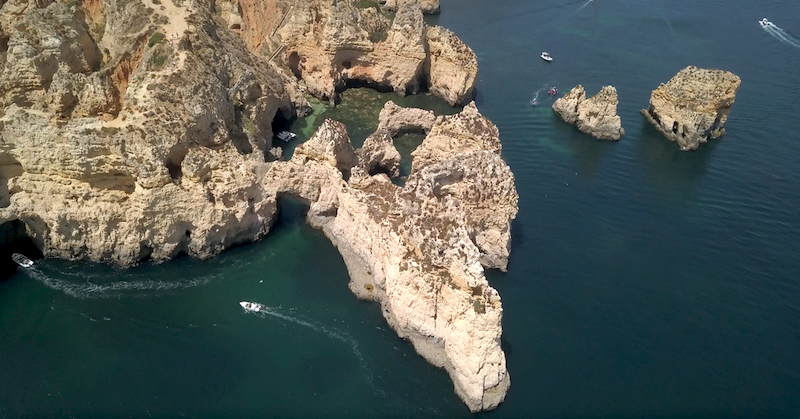The Ria Formosa lagoon was so expansive, it felt like we were anchored on an inland lake, a lake with just a few hundred of our sailing brethren. Once we had backed down on our anchor and ensured that it was going to hold our floating home securely, I launched one of the paddle boards and started exploring around the anchorage. It quickly became apparent that despite being inland, the waters here were too chopped up to make paddle boarding safe, let alone enjoyable. It seemed like a constant line of high speed taxi boats were running from the ferry landing to the mainland, back and forth with reckless abandon. Before I embarrassed myself with a wobbly, on-a-constant-threshold-of-falling paddling experience, we opted to dinghy into shore and check out the scene on Culatra.

A few small restaurants seemed to be positioned close to the water to give the waiting ferry passengers something to do; but otherwise, visitors were trudging along a well worn path to the Atlantic side of this low-lying, sand-filled barrier island.


Long stretches of beach and dunes ran the length of the island, reminding me of Cape Cod and the island of Nantucket back home. You could picture how each tidal cycle would gradually reshape this wispy island, bending it to the will of nature.
In the morning, we travelled by dinghy up into the tidal reaches of the Ria Formosa as the tide started rising from its lowest point. Beach area that would be squeezed down to 15-20 feet would run out a hundred or more feet at low tide. Shallow areas in the lagoon would dry up at low, giving you a chance to explore a sand spit before the incoming waters soon covered it all back up. And all the while, the kiss of a cloudless sky nurtured our soul with the tranquility of summer’s bountiful sunshine. Our departure from Greece two months back felt like a lifetime ago; we had made huge progress in our goal of exiting the Med, and if this was what we had to confront as we moved into the the tidal territory of the Atlantic, count me in!
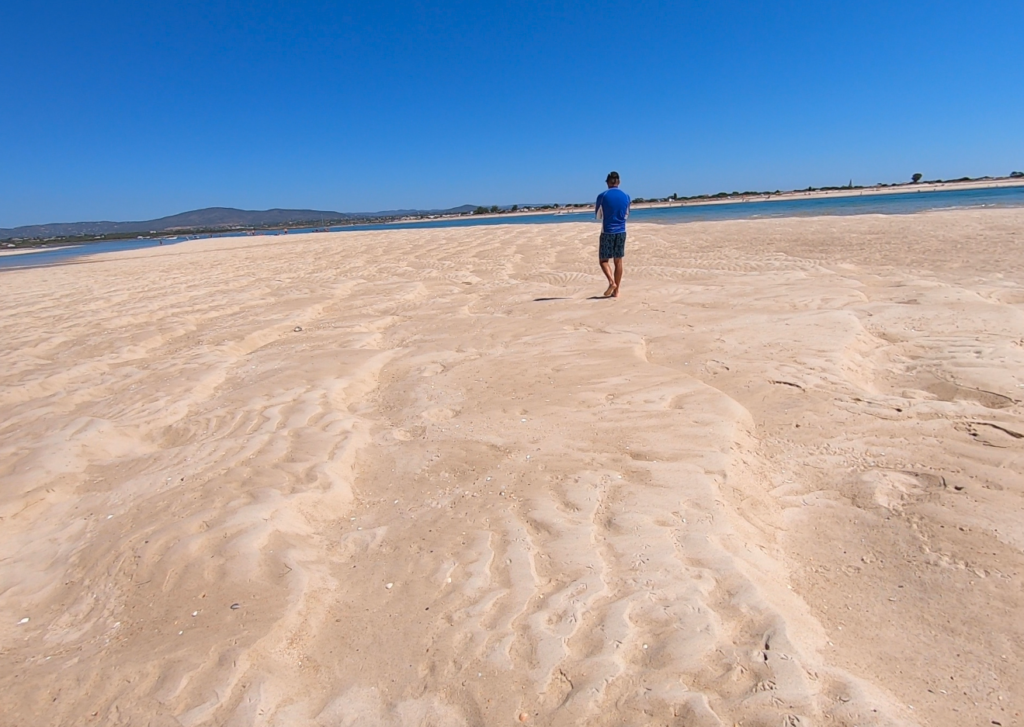

With our proximity to the city of Faro, and a worsening situation with one of my eyes, we took the opportunity to visit a nearby ophthalmologist for advice. I had been getting flashes in my right eye, similar to what I experienced two years ago in Croatia. A nice young doctor took me in right away, speaking perfect English and having trained for a brief period in Boston. I once again was having a common aging phenomenon of Posterior Vitreous Detachment. As long as I took it easy, I would recover fine.
And, Faro was the perfect little city to take it easy. We walked all throughout the old section on intricate inlaid stone pathways leading to broad squares and past chapels with proud facades topped with imposing belfries. This was a town we agreed we could call home for an extended sabbatical.

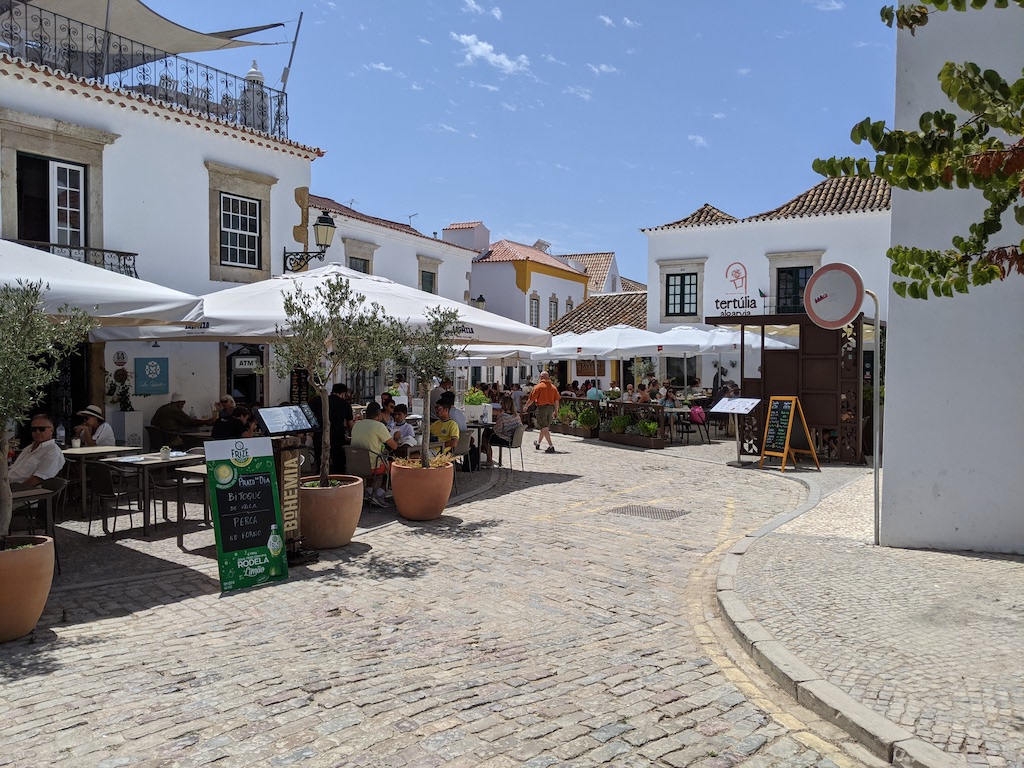

But a sabbatical would have to wait. Moderate weather was in the forecast for the next few days and we felt the tinge of haste as we re-examined our timing for the rest of the season. We rode the swiftly running ebb tide out of the grand Ria Formosa lagoon, which introduced us back into the Atlantic with a band of standing waves and white water. As the hulls of two boats ahead of us alternately disappeared behind the crest of the waves, and their bows pierced the sky as the rode up the next wave, we braced ourselves for impact. The common refrain that boating is 98% boredom, 2% sheer fear kept running through my mind. As it went, Sea Rose rose up and down the waves with relative ease – the wave’s bark was worse than its bite – and we set a course for Portimao, 30 miles to the west. Along the way, reminders were frequent about the Algarve appeal. Tour boats were running visitors out from small harbors towards rocky cliffs, caves and tranquil beaches tucked in between them. It seemed that every floating vessel was put to use here. A rainbow of colorful kayaks strung their way through amphitheater-shaped cliff overhangs. Day boats busting at the bulwarks with sightseers were stopping to anchor and give everyone a chance to cool off in the water. It reminded me of my summers in high school working for a local sailboat rental company in San Diego. On sunny weekends, we would float every possible boat we had, some that you might even question their seaworthiness, but it was an important lesson in economics 101.
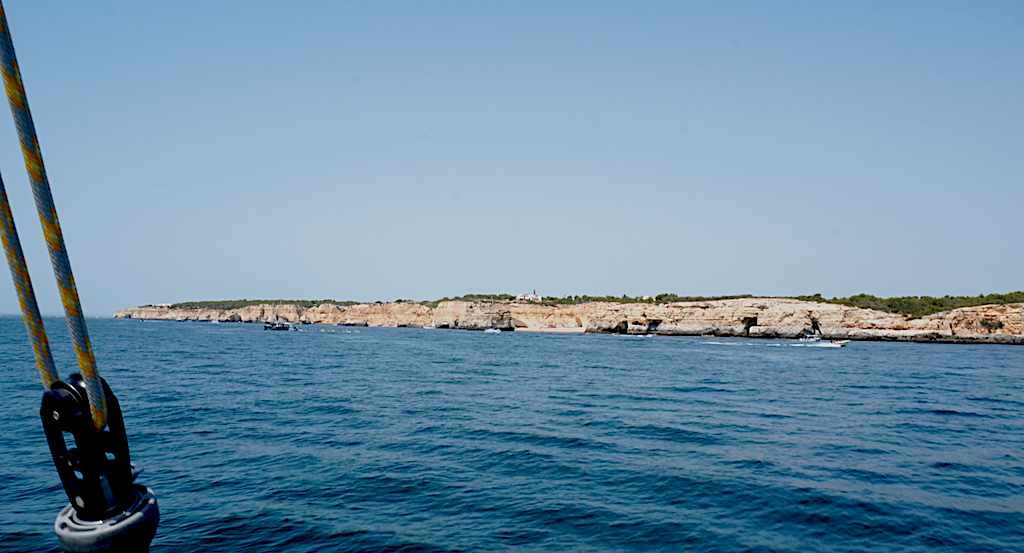
Friends had recommended Portimao as a preferred stop along this stretch of the Algarve. We quickly discovered that the smaller village on the opposite side of the harbor, Ferragudo, was the real belle of this anchorage. Narrow walkways were draped with bougainvillea swaying gently in the breeze and a restaurant popular for their barbecued fish displayed their wares on the waterfront. We chose to dine away from the water in hopes of finding something more authentic in an already quite authentic village. We stumbled upon a small square the size of a basketball half-court. Every inch was taken up by four competing restaurants while a lively guitar player strummed a mix of classic American songs and local favorites that invited many diners to sing along. We had been tipped off by our Portuguese friend Pedro to try a local fish stew specialty called cataplana. We were going to wait until we got to Lisbon, but he encouraged us to not procrastinate – the dish was apparently hard to find outside of the Algarve. It was a sumptuous mix of several white fishes, clams, muscles, prawns, potatoes and other vegetables in a light tomato/saffron base.
Our pain for such tasty pleasure was finding our dinghy at midnight firmly aground at the fishing pier! But with a 3 meter tide, the good news is things change quickly. Within 45 minutes, we were afloat enough to wade through the muck to deeper water and putt-putt our way home to Sea Rose.




With all of the rocky cliffs along the Algarve, the options for safe harbors to stop at overnight are quite limited. The next obvious option to the west was the port of Lagos, another half-day excursion which we motored on account of the consistently lacking wind. Lagos has a few good marina and haul out facilities, as well as one of the best stocked chandlery’s along this stretch of the Atlantic. Walking into the store felt like being back at one of the large West Marine stores at home, and they successfully liberated a few more euros from our wallet than we had originally planned to spend.
Lagos was a buzz in the evening with no shortage of couples seeking out the most romantic setting for cocktails. Clearly there was more that attracted visitors to this Algarve town than an impressive chandlery. We did our best to balance out the age span with these younglings as we saddled up to a cafe to share a liter of house wine and nibblies.


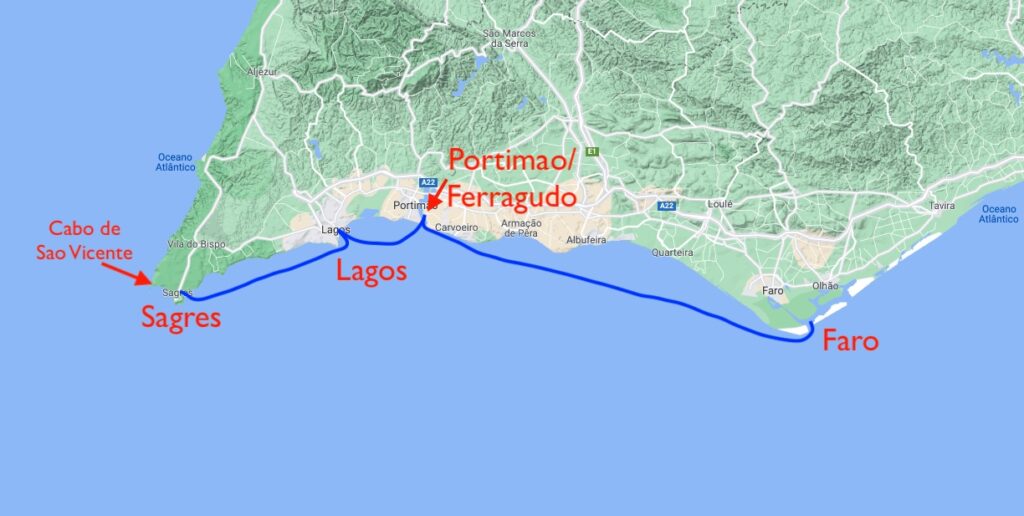
The next navigational challenge in front of us was the transit up the coast to Lisbon from the pointy southwest corner of Portugal named Cabo de Sao Vicente. We had been captivated all summer by the news of orca attacks, but the next most popular feature on the worry list was this north/south coastline of Portugal. Large seas coming in from the Atlantic did not behave like their kinsmen and women elsewhere. Due to a deep ocean trough that ended abruptly close to the land, and the steep rocky nature of much of the coastline, rough and confused waves were common along this part of Portugal. Making it even more unpleasant was the prevailing winds coming down from the north. The cruising guide suggested the best way to minimize the discomfort was to travel from north to south, and quickly. We could do quick, yet we had no choice but to go north. We had been checking the wind forecast over the last few weeks and as luck would have it, the winds were shifting to the west, which would allow us to more easily sail. And, if we waited long enough after the wind change, we could hope for the dominant swell pattern to shift to the west as well. Facing the possibility of having both wind and waves from somewhere other than right on our bow was music to our ears. We had one more hop to make, to the harbor of Sagres, and then we would be in striking distance.
As we hoisted our anchor from the waterfront off of Lagos the next morning, more tour boats were racing out of the river than we had ever seen before, and the reason for their eagerness was made obvious right as we approached a large collection of rock pinnacles, caves, and grottos just ahead named Ponta de Piedade. We had passed several of these types of sites earlier along the Algarve, but despite our time pressures it felt foolish to not anchor up here and checkout this incredible creation of Mother Nature.


We launched our paddle boards, timing the step across to them carefully to avoid the heavy surge rolling our stern from side to side. With all of the tour boat traffic, these waters were being chopped up like a washing machine. But for good reason. The coastal cliff line ran an undulating course around haystack rocks, arches, and deeply inset grottos, some with shafts of sunlight breaking through. If you weren’t on a kayak or paddle board, the next best option was a little four person skiff with a guide. Any larger of a boat would not get through the obstacle course of rocks. At times we waited in line behind rows of skiffs pumping out noxious outboard pollutants in a semi-enclosed space. This, combined with the guide’s aggressive actions to show their patrons the most grottos for their euros, led to Karen’s paddle board being shoved aside against a row of dangerously sharp rocks. We felt like targets in a firing range. I could manage to co-exist with fishermen anchored in navigation channels looking for their next meal, but when grotto tour guides use intimidation to endanger my wife, I have no sympathy. It was time for us to move on.
Our last planned stop along the Algarve was the harbor of Sagres. The cluster of buildings around the anchorage form a hamlet of just 2000 people, but you’d have to have your head buried deep in Algarve sand to not recognize the name. Sagres, the local brew from Lisbon, sponsors several regional football teams, as well as the Portuguese national team. Their logo is emblazoned all over this land, from shirts to cafe umbrellas, to tall beer glasses (not all of which get returned to the wait staff)!
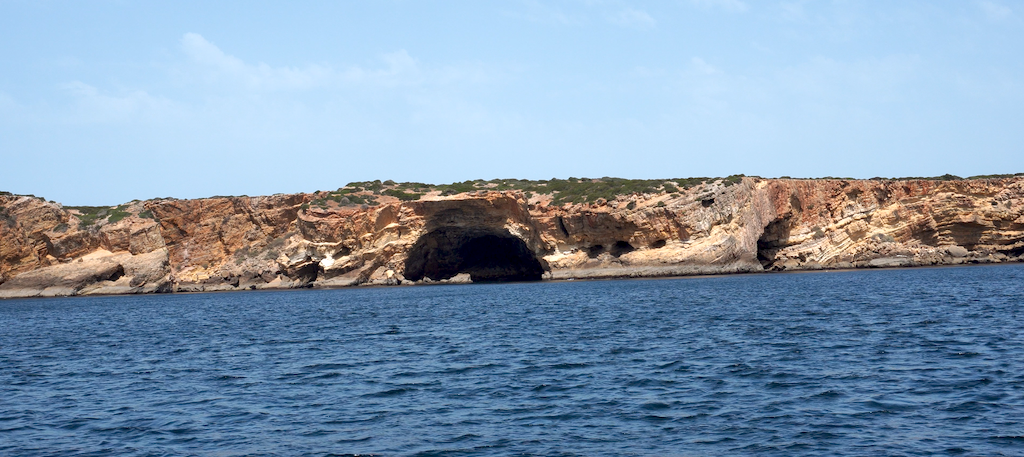
A moderate offshore breeze allowed us to sail gently along this coast, as we let the memories of crowded grottos trickle away in our wake and enjoy more rugged, untouched beauty where sea meets sand. The coastline on this southwest tip of Portugal points out sharply into the Atlantic, making it off the beaten path for many. We had made good time from Lagos, permitting us a chance to peek around this tip of land, where several hundred foot tall cliffs dropped vertically to the sea. Around the western side, the sea state changed instantly. A pronounced long ocean swell rolled in from seaward. As it struck the vertical rock walls, reflected waves tossed our bow off course. Sea Rose rose up sharply on the crest of the next wave, and fell down into the following trough. These long period waves had a classic ocean pedigree. We were no longer in the protected Mediterranean, nor the ‘baby’ Atlantic after leaving Gibraltar. This was the real thing, and frankly, it was a little intimidating! It was time to wrap up the rehearsals; the real show was about to begin. We made an about-face and motored into the Sagres harbor to prepare ourselves, picking a sandy spot to anchor off the broad beach bookmarked by tall cliffs. A beer seemed like the appropriate tonic for our tremors!
